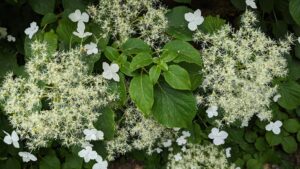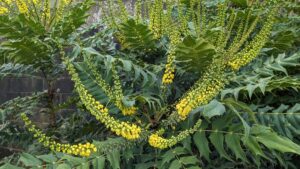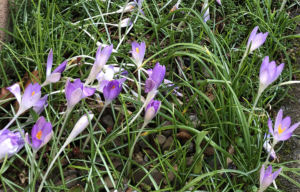
 |
Robust and Reliable --- Hydrangea petiolaris also known as Climbing hydrangea | Hydrangea petiolaris is a large self clinging climber. It has lovely glossy oval green leaves that turn golden yellow in Autumn. In late Spring you will see pincushions of large creamy white lacy flower heads made up of tiny individual flowers. Look for our Hydrangea petiolaris starting its climbing journey up the tall back wall. This Hydrangea copes even in very shady spots. --- Did you know? Hydrangea petiolaris climbs using aerial roots. These are root structures but above the ground. They enable the plant to climb and take in extra water and nutrients. |
 |
Fabulous Fragrance --- Syringia also known as Lilac or Common Lilac | Syringia. Our Syringia will look at their best between May and June. Syringia smells amazing and flowers prolifically. Syringia has pretty dark green almost heart shaped leaves and masses of gently drooping pointed clusters of teeny flowers in shades of lilac. Syringia also flower in deep purple, magenta and white and even pale lemon yellow. --- Did you know? Syringia has a delicate pastel like fragrance much used in perfumes. The flowers are also used to make lilac wine. |
 |
Wildlife Welcomer --- Honeysuckle also known as Lonicera caerulae, Honeyberry, Fly honeysuckle | Honeysuckle. This shrub has attractive grey green leaves. You will see small funnel shaped gently fragrant creamy white flowers in early Spring. In early Summer it has dark blue berries. --- Did you know? Honeysuckles are best known for their climbing habit, but this Honeysuckle is non- climbing and forms a vigorous shrub. |
 |
Fantastic Foliage --- Mahonia | Mahonia is a tall dramatic winter flowering shrub. You will be able to spot it towards the back of the bed between November and March. Mahonia has striking big dark green holly like serrated leaves and slender spikes of pale yellow flowers. The flowers have the bonus of a lovely sweet fragrance. They are a great source of winter nectar for pollinators. After flowering Mahonia produces deep purple berries loved by birds. --- Did you know? Mahonia berries are toxic and must not be eaten. |
 |
Seasonal Showstopper --- Forsythia | Forsythia. You will see our Forsythia flowering from late February through to April. It is a tall shrub at the back of this bed. Forsythia blossom is a cheerful sight at the start of Spring. The branches will be smothered in vivid yellow flowers. The flowers appear before the bright green leaves. --- Did you know? Forsythia stems make excellent cut flowers. Cutting the stems also prevents the shrub from growing too large. |
 |
Seasonal Showstopper --- Skimmia also known as Skimmia japonica or Japanese skimmia | Skimmia are beautiful evergreen shrubs with lovely glossy dark green leaves. In Spring you will see soft white flower clusters. In winter the shrubs will be covered in dense clusters of very bright red berries just as long as a male Skimmia is growing somewhere nearby. Birds love to eat the berries. --- Did you know? Skimmia can be male or female shrubs. Only the females produce berries. They almost all need a nearby male plant for pollination. Skimmia can also have white berries. All parts of Skimmia are toxic to humans. |
 |
Beautiful Bulbs --- Daffodil also known as Narcissus | Daffodils. In the Springtime you will enjoy our selection of golden yellow daffodils. They are grown from bulbs, and once planted Daffodils will return year after year and gradually spread. This spreading is called ‘naturalising’. Daffodils have slim green leaves and straight slim stems topped by bright trumpet shaped flowers, usually orange, white or yellow surrounded by six petals. --- Did you know? Daffodil bulbs are toxic and are easily mistaken for onions so never plant them in vegetable plots. |
 |
Beautiful Bulbs --- Crocus also known as the Saffron crocus or Crocus sativus | Crocus. You will see these cheerful little low growing flowers in late Winter and Early Spring. The flowers are yellow, white or purple. Crocuses are a great source of pollen for early emerging pollinating insects. Crocuses love winter sunshine and will happily grow in borders, pots or grassy meadows. --- Did you know? The prized spice Saffron comes from the stigma of the crocus. Saffron is often used to flavour paella and other rice dishes. Each crocus produces only three tiny orangey red saffron stigma inside the petals. Saffron is very fiddly to harvest. This explains why it is very expensive. |
From here walk slightly uphill on the main road to reach Castle Corner bed.
Disclaimer
Our plants are grown for ornamental purposes only. We do not advise touching or ingesting any parts of the plants on the Duns Flowerbed Trail. Many plants can be an irritant or toxic when smelt, ingested or touched. All the ‘Did you know?’ information about alternative plant use is provided for educational interest only.
